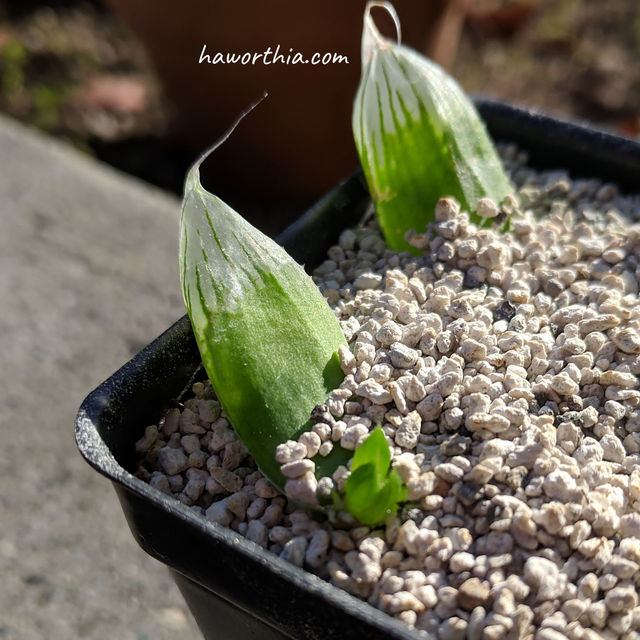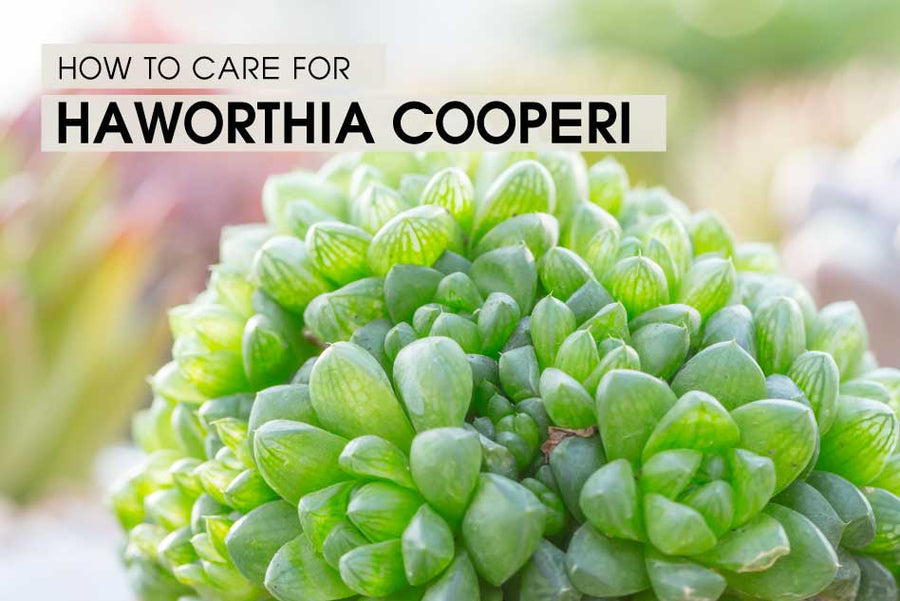With the charm of its adorable size that would look just great in any living space, Haworthia Cooperi is a succulent that any collector desires! Plus, they make an excellent mantlepiece plant, and growing them doesn't need much effort at all. They can thrive even under neglect, making them ideal for someone who is always on the go!
To give you a better idea of how easy it is to keep this amazing succulent happy, we have shared everything you'll need to know about growing Haworthia Cooperi.
Description
Native to South Africa, Haworthia Cooperi Var. Obtusa is a stemless, rare succulent that forms rosettes of fleshy, smooth, and round-tipped lovely blue-green translucent-patterned leaves that look like tiny clear watermelons and can grow only between 3 and 5-inches tall and 4-inches in diameter.
General Care
Despite their delicate appearance, Haworthia Cooperi succulents are incredibly hardy and can thrive in a variety of environments. Like all Haworthia, Haworthia Cooperi takes a long time to fully mature (development periods can last from six months to a year) and live for many years.
1. Light Requirements
Compared to most succulent plants, Haworthia Cooperi is a bit shy when it comes to light exposure. So if you are planning to grow yours outdoors, find a spot where it can get about 4 to 5 hours of bright, indirect morning sunlight per day. But if you want to grow it as an indoor houseplant, you can display this plant near an east or west-facing window where it can get just the right amount of light it needs.

A south or west-facing window will also do, but you'll have to acclimate the plant first to prevent any sun damage, as these spots usually provide direct sunlight. You can do this by placing your Haworthia Cooperi near the south or west-facing window and putting a few pieces of tissue paper on top of it. Then every couple of days, you can remove a layer of tissue paper.
If you don't get much light around your area, use a grow light to supplement natural sunlight. When you see your Haworthia Cooperi leaves have become softer and greener, or it has started to stretch and lose their compact form, bring out the light. If the leaves have become pale or yellow, or you see that the plant’s color has become very dull, then it's a sign that your Haworthia Cooperi is getting too much sunlight, so consider moving it to a different spot.
2. Watering Demands
How often you water your Haworthia Cooperi depends on its growing environment. To make it simple, water your succulent deeply during the fall to spring growing season. Water at least once a week, or whenever the top two inches of soil feel dry and be sure to let it drain completely.

In the winter months, when Haworthia Cooperi will go dormant, so reduce your watering to once a month or whenever you see that its leaves are starting to shrivel.
Following this watering routine should keep this plant well hydrated, and at the same time, helps you prevent the plant from getting too much moisture, which is the number 1 cause of root rot.
3. Ideal Temperature
The ideal temperature to grow Haworthia Cooperi Var. Obtusa is between 68F to 72F. It can withstand cooler temperatures for as low as 50F.
However, extremely cold temperatures can gravely affect the growth of this plant. So if you are located in an area where the temperature tends to drop below 40F, it is best to grow this succulent as an indoor houseplant or plant it in a pot or container where you can easily move it around for protection from any freezing injury.
To be specific, this succulent will do great in USDA zones 9 to 10.
4. Best Soil Mix
Haworthia Cooperi should also be grown in well-drained, sandy soil like any other succulents. You can create your own soil mix by blending equal parts of regular potting soil, coarse sand, and perlite with shredded bark or compost. You can also buy a commercially available cactus or succulent soil mix, then add perlite or pumice to promote better drainage.

Blooming
Fortunately, Haworthia Cooperi flowers don’t signal your succulent’s death. Instead, Haworthia Cooperi flower at the height of their growing season if given plenty of sunlight. These adorable succulents have adorable flowers too, which range in color from white to a pink-white or light green. To encourage blooming in your Haworthia Cooperi, slowly begin transferring it to full, indirect sunlight during its growing season.
Propagating Haworthia Cooperi
One of the best parts of growing Haworthia Cooperi is that it can easily be propagated from a leaf. However, it’s best to propagate during your succulent’s growing season, so the leaves have plenty of time to acclimate to their new environment, and your parent plant can heal without potential difficulty.

To propagate, you just have to follow 3 simple steps:
Step 1: Get a few healthy leaves from a pest-free mother plant.
Step 2: Place the leaves on a surface for about a day or until they callous over.
Step 3: Once callus has formed, place the leaves at least 2-inches away from each other in a tray filled with fresh moist potting mix.
And you're done! At this point, you should have to make sure to keep the soil moist by misting it with water at least once every 2 days in the morning.
If you wish to propagate your Haworthia Cooperi from stem cuttings, the best time to do so is when your original plant starts growing leggy from uneven sunlight. Using a knife or a pair of clean, sharp scissors, cut the plant at the lowest point on the stem. Then, let the cutting callous over before planting again. With offshoots, you can simply treat the process like you would a stem cutting, and behead the baby offshoots to transplant them into new pots.Repotting your Haworthia Cooperi
Repotting Haworthia Cooperi is easy. Plus, you don't have to repot it so often as you will only need to do it when the soil has become poor in quality and you want to give it a fresh new one, or you wish to put it together with your other succulent collections.
To repot, you can follow the 4 simple steps below:
Step 1: Remove the small clumping succulent from its container.
Step 2: Shake off any excess soil and rinse the roots using room-temperature water.
Step 3: Plant your Haworthia Cooperi in a new pot and fill the container with a cactus/succulent soil mix.
Step 4: Water thoroughly and place it in a spot where it can get bright, indirect sunlight.
Repotting is best done in spring or early summer when this plant is less prone to stress.
Common Pests and Complications
Generally, Haworthia Cooperi is quite resistant to pests, which is one of the best traits of this plant. However, it can still get infected by fungal gnats, which can be caused by overwatering or when the soil has become too moist. Although not harmful, they can be a nuisance, especially if you grow your plant indoors. Still, always keep watch for common pests like aphids, mealybugs, and spider mites!

If your plants have become infected by fungal gnats, quickly remove it from the soil and discard it or throw away at least the top 2-inches of the soil. Then soak the plant in a 1% hydrogen peroxide solution for about 15 minutes before planting it in a fresh, new potting medium.
After that, you just have to strictly follow the proper watering routine to avoid your plant from being infected again.
Diseases
The most common disease to afflict your Haworthia Cooperi is Fungal disease, which can be developed when the plant is left sitting in wet soil for too long and can eventually lead to its death.
To save or treat your plant Haworthia Cooperi affected by this disease, quickly replace the potting medium with a new, fresh one and make sure to remove any decayed roots before planting it again.
FAQs
1. Is Haworthia Cooperi Var. Obtusa toxic to people or animals?
- No. Haworthia Cooperi is not poisonous to any animals nor people.
2. Why is my Haworthia cooperi succulent dying?
- The number one cause of a dying Haworthia Cooperi is overwatering. You'll know that you are already giving this plant too much water when its leaves start to feel soggy or mushy and may also fall off easily.
- To fix this, you either need to repot it to a new and fresh soil mix or cut back with your watering until its soil feels completely dry.
3. Why is my Haworthia Cooperi turning brown?

- Discoloration is mostly caused by overexposure to sunlight. It can either turn the leaves to brown, purple or even red. So as soon as you notice that your plants are starting to produce these colors, consider transferring it to a different spot, where it's shadier.
See more about HOW TO GRAFT A CACTUS
Click here to get all the details.
If you found this article interesting,
And get a free plant when your friends make an order. Sign up here!
Learn more about how to nurture and enjoy many gorgeous succulents and clever decoration tips with our newsletter. Let's sign up!
Recommended Items

































































































